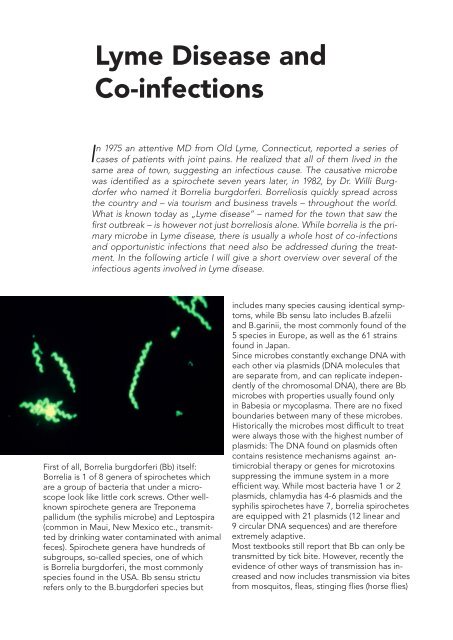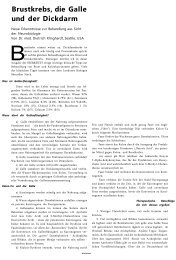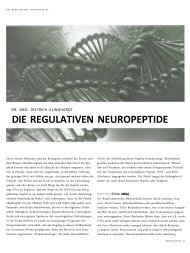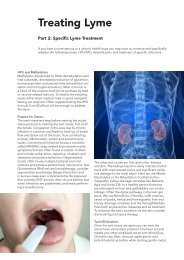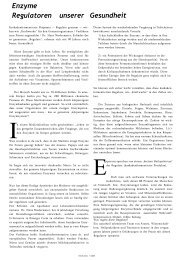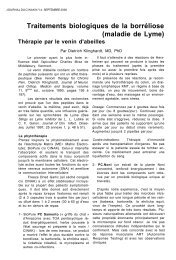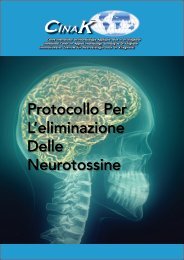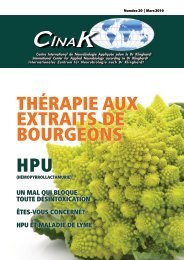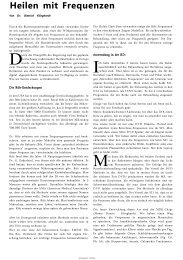Lyme Disease and Co-infections - Cinak
Lyme Disease and Co-infections - Cinak
Lyme Disease and Co-infections - Cinak
You also want an ePaper? Increase the reach of your titles
YUMPU automatically turns print PDFs into web optimized ePapers that Google loves.
<strong>Lyme</strong> <strong>Disease</strong> <strong>and</strong><br />
<strong>Co</strong>-<strong>infections</strong><br />
n 1975 an attentive MD from Old <strong>Lyme</strong>, <strong>Co</strong>nnecticut, reported a series of<br />
I cases of patients with joint pains. He realized that all of them lived in the<br />
same area of town, suggesting an infectious cause. The causative microbe<br />
was identified as a spirochete seven years later, in 1982, by Dr. Willi Burgdorfer<br />
who named it Borrelia burgdorferi. Borreliosis quickly spread across<br />
the country <strong>and</strong> – via tourism <strong>and</strong> business travels – throughout the world.<br />
What is known today as „<strong>Lyme</strong> disease“ – named for the town that saw the<br />
first outbreak – is however not just borreliosis alone. While borrelia is the primary<br />
microbe in <strong>Lyme</strong> disease, there is usually a whole host of co-<strong>infections</strong><br />
<strong>and</strong> opportunistic <strong>infections</strong> that need also be addressed during the treatment.<br />
In the following article I will give a short overview over several of the<br />
infectious agents involved in <strong>Lyme</strong> disease.<br />
First of all, Borrelia burgdorferi (Bb) itself:<br />
Borrelia is 1 of 8 genera of spirochetes which<br />
are a group of bacteria that under a microscope<br />
look like little cork screws. Other wellknown<br />
spirochete genera are Treponema<br />
pallidum (the syphilis microbe) <strong>and</strong> Leptospira<br />
(common in Maui, New Mexico etc., transmitted<br />
by drinking water contaminated with animal<br />
feces). Spirochete genera have hundreds of<br />
subgroups, so-called species, one of which<br />
is Borrelia burgdorferi, the most commonly<br />
species found in the USA. Bb sensu strictu<br />
refers only to the B.burgdorferi species but<br />
includes many species causing identical symptoms,<br />
while Bb sensu lato includes B.afzelii<br />
<strong>and</strong> B.garinii, the most commonly found of the<br />
5 species in Europe, as well as the 61 strains<br />
found in Japan.<br />
Since microbes constantly exchange DNA with<br />
each other via plasmids (DNA molecules that<br />
are separate from, <strong>and</strong> can replicate independently<br />
of the chromosomal DNA), there are Bb<br />
microbes with properties usually found only<br />
in Babesia or mycoplasma. There are no fixed<br />
boundaries between many of these microbes.<br />
Historically the microbes most difficult to treat<br />
were always those with the highest number of<br />
plasmids: The DNA found on plasmids often<br />
contains resistence mechanisms against antimicrobial<br />
therapy or genes for microtoxins<br />
suppressing the immune system in a more<br />
efficient way. While most bacteria have 1 or 2<br />
plasmids, chlamydia has 4-6 plasmids <strong>and</strong> the<br />
syphilis spirochetes have 7, borrelia spirochetes<br />
are equipped with 21 plasmids (12 linear <strong>and</strong><br />
9 circular DNA sequences) <strong>and</strong> are therefore<br />
extremely adaptive.<br />
Most textbooks still report that Bb can only be<br />
transmitted by tick bite. However, recently the<br />
evidence of other ways of transmission has increased<br />
<strong>and</strong> now includes transmission via bites<br />
from mosquitos, fleas, stinging flies (horse flies)
<strong>and</strong> spiders as well as<br />
blood transfusions,<br />
sexual intercourse,<br />
kissing, trans-placentar<br />
transfer to the fetus,<br />
breast feeding <strong>and</strong><br />
contaminated utensils like telephones. Therefore<br />
asking a patient if they remember a recent<br />
tick bite is not an adequate anamnesis.<br />
Borreliosis goes through several stages. At the<br />
first stage, patients will have flu-like symptoms.<br />
Only about 25 % of them report joint pains.<br />
Here antibiotics will be effective. Often patients<br />
enter the second stage after many near-asymptomatic<br />
years. They complain about muscle<br />
aches, fatigue, joint pain, “migratory arthritis“,<br />
meningitis <strong>and</strong> loss of appetite. Finally the<br />
third stage, often after many years of milder<br />
illness: Patients show severe chronic neurological<br />
symptoms, profound fatigue, memory loss,<br />
severe pain, depressions <strong>and</strong> even psychosis.<br />
All asymptomatic carriers are at risk of developing<br />
symptomatic borreliosis; often a temporary<br />
immune suppression by stress causes the activation<br />
of the disease.<br />
There are 6 major sites of infection, each with<br />
characteristic symptoms:<br />
1. Large joints <strong>and</strong> connective tissue: onset<br />
4.3 months after insect bite, often self-limited<br />
(4 years). Flare-ups during Herxheimer<br />
reactions very common<br />
2. Skin <strong>and</strong> connective tissue (B.afzelii): acrodermatitis<br />
chronica atrophicans, general<br />
collagen breakdown (premature ageing),<br />
collagen diseases, ...<br />
3. CNS (B.garinii), PNS <strong>and</strong> ANS: after an insect<br />
bite it only takes a few hours until spirochetes<br />
are found in CNS even though it<br />
takes on average 2 years before symptoms<br />
are established. Most common symptom:<br />
brain fog <strong>and</strong> short term memory loss. Later<br />
stages: demyelination. Severe early changes<br />
can be found in SPECT scan (functional),<br />
MRI changes occur much later (physical);<br />
CNS: epileptic seizures, insomnia, tremor,<br />
ataxia, movement disorders (torticollis,<br />
etc.); irritability (key symptom in children),<br />
depression, bi-phasic behavior (manic depression),<br />
bouts of anger, listlessness; confusion,<br />
difficulty thinking, poor short term<br />
memory, increasingly messy household <strong>and</strong><br />
desk, difficulty finding the right word, feeling<br />
of information overload; can resemble<br />
or imitate any known psychiatric illness.<br />
Chronic Fatigue (more severe in the early<br />
afternoon); Lack of endurance; Non-healing<br />
<strong>infections</strong> in the jaw bone, devitalized<br />
teeth, dental pain; Fibromyalgia; Multiple<br />
Chemical Sensitivity; loss of zest for life,<br />
sensitivity to electric appliances.<br />
PNS: Paresthesia, burning, vibration, numbness,<br />
shooting pains.<br />
Cranial Nerve Problems:<br />
Facial nerve: Bell’s palsy (60 % are caused<br />
by <strong>Lyme</strong> disease, 30 % by one of six common<br />
viruses from the herpes family, such<br />
as EBV, Herpes simplex type I, type II, type<br />
6 etc); Trigeminal nerve: sense of vibration<br />
in the face, TMJ <strong>and</strong> facial pain, headache,<br />
tension <strong>and</strong> cramps in the face/skull/jaw;<br />
dental pulpitis, formation of jaw bone cavitations.<br />
Ears (VII, VIII): tinnitus, vertigo, <strong>and</strong> hypersensitivity<br />
to noise;<br />
Eyes (II, III, IV, VI): decreasing <strong>and</strong> changing<br />
eye sight (fluctuates during the day), light<br />
sensitivity, floaters;<br />
Vagus (X), Glossopharyngeal nerve (IX)<br />
<strong>and</strong> Hypoglossus (XII): difficulty swallowing,<br />
faulty swallowing, reflux, hiatus hernia,<br />
heart palpitations, supraventricular arrythmias.<br />
4. Heart: <strong>Lyme</strong> carditis is difficult to diagnose<br />
with current methods (PET scan positive<br />
early on) <strong>and</strong> has multiple symptoms from<br />
arrhythmia to angina. Has to be taken serious<br />
with first symtptoms.<br />
5. Kidney, bladder: the highest concentration<br />
of tissue spirochetes has been found<br />
in kidney <strong>and</strong> bladder. Symptoms often<br />
include interstitial cystitis, prostatitis (Babe-
sia often also involved), sexual dysfunction,<br />
loss of libido, pelvic pain, menstrual disorders,<br />
filtration problems in the kidney (low<br />
specific weight of urine)<strong>and</strong> urethritis after<br />
intercourse (the spirochetes are attracted<br />
during intercourse to the urethra <strong>and</strong> cause<br />
acute inflammation).<br />
6. Immune system <strong>infections</strong> (white blood<br />
cells, thymus, brain, lymphnodes, adrenals,<br />
etc): non-healing <strong>infections</strong> in the jaw bone<br />
(also Babesia, Bartonella), devitalized teeth,<br />
dental pain, Immune system failure: with all<br />
known secondary illnesses such as herpes<br />
virus infection, intestinal parasites, malaise,<br />
hair loss, hepatitis C.<br />
Diagnosing Bb:<br />
There are several lab<br />
tests available for borrelia<br />
that can be used to<br />
make a diagnosis: Direct<br />
microscopy (www.<br />
Bowen.org, www.BradfordResearchInst.org),<br />
Detection of antibodies<br />
(ELISA, Western Blot),<br />
Lymphocyte proliferation<br />
tests (MELISA <strong>and</strong> LTT),<br />
CD 57 Stricker panel,<br />
ART testing (www.neuraltherapy.com,<br />
www.<br />
INK.ag ), indirect tests<br />
(FACT, different lab<br />
parameters). However,<br />
spirochetes can assume<br />
a cystic form which can lay dormant in tissues<br />
<strong>and</strong> escape detection from any diagnostic<br />
method. Also, the cells of the immune system<br />
responsible for making antibodies are usually<br />
sick <strong>and</strong> cannot produce antibodies. The Western<br />
Blot turns positive as soon as an effective<br />
treatment has been given – not before. Therefore<br />
you first have to treat before you can make<br />
the diagnosis.<br />
Several lab parameter configurations are typical<br />
for an infection with Bb: Abnormal lipid profile<br />
(moderate cholesterol elevation with significant<br />
LDL elevation), elevated triglycerides (=<br />
early response) or very low triglycerides (late<br />
response), insulin resistance, borderline low<br />
wbc (3000-5000), normal SED rate <strong>and</strong> CRP,<br />
low-normal thryroid hormone tests but positive<br />
Barnes test <strong>and</strong> excellent response to giving<br />
T3, adrenal failure or weakness (high cortisol<br />
in early stage, low cortisol, DHEA <strong>and</strong> testosterone<br />
in late stage <strong>Lyme</strong>), low alkaline phosphatase<br />
(indicating low zinc levels, usually from<br />
lyme associated HPU), decreased urine concentration<br />
(low specific gravity), positive test for<br />
HPU.<br />
An acute infection with borrelia may respond<br />
to the textbook antibiotic treatment (ceftriaxon<br />
or doxycyclin). For the treatment of chronic<br />
borrelia <strong>infections</strong> I recommend the Klinghardt<br />
<strong>Lyme</strong> <strong>Co</strong>cktail which has to be taken longterm<br />
in order to catch the cystic forms.<br />
As I mentioned earlier, most patients present<br />
with co-<strong>infections</strong> <strong>and</strong> opportunistic <strong>infections</strong>.<br />
The latter include viral, mold <strong>and</strong> yeast <strong>infections</strong><br />
as well as parasite infestations settling in<br />
comfortably after the immune system has been<br />
compromised. The discussion of these I will<br />
save for another article while focussing on the<br />
most important of the co-<strong>infections</strong> in this one.<br />
We often find Babesia, Bartonella, <strong>and</strong> Rickettsia<br />
species such as Ehrlichia in <strong>Lyme</strong> patients.<br />
Babesia are intracellular Malaria-like protozoal<br />
organisms that infect the red blood cells.<br />
2/3rds of <strong>Lyme</strong> patients are also infected with<br />
Babesia. Since there are 17 known antigen-different<br />
subspecies, each requiring a very specific<br />
lab test, they are often overlooked. The most<br />
common strains are B.microtii in the Western<br />
United States <strong>and</strong> B.divergens in Europe. The<br />
best way to diagnose a Babesia infection is<br />
ART or long term observation of blood under<br />
the darkfield microscope: Babesia tend to leave<br />
dying cells while under darkfield observation.<br />
Symptoms of Babesia infection include: Vertigo,<br />
headache, fatigue, eye problems (floaters,<br />
blurry vision), dental problems (accelerated<br />
tooth decay, cavitation formation), TMJ problems,<br />
fibromyalgia, shortness of breath, malaise<br />
as well as drenching night sweats <strong>and</strong> fever/<br />
chills during Herxheimer reactions.
years), myalgia, arthralgia, headaches, leukopenia,<br />
thrombocytopenia, hyponatremia, mental<br />
confusion, skin rashes, genital <strong>and</strong> oral ulcers,<br />
nausea, vomiting (acute flare-ups), <strong>and</strong> severe<br />
pain syndroms.<br />
Bartonella henselae is the most commonly<br />
found intracellular co-infection in red blood<br />
cells, endothelial cells, bone marrow <strong>and</strong> in<br />
macrophages. An estimated 70% of the cats in<br />
Italy are infected (c“cat’s scratch disease“), <strong>and</strong><br />
cat to human transfer is common. Symptoms<br />
include swollen lymph gl<strong>and</strong>s, endocarditis,<br />
hepatitis, neovascularization, fatigue, low grade<br />
fever, jaw bone cavitations, devitalized teeth,<br />
fibromyalgia <strong>and</strong> joint pain. We often find it as<br />
a co-infection in ALS patients.<br />
Ehrlichia <strong>and</strong> other rickettsia are often found<br />
in patients who have contact with horses <strong>and</strong><br />
farm animals. They are also common in dogs<br />
<strong>and</strong> their owners. Symptoms include fever<br />
(after initial infection, sometimes recurrent for<br />
The Klinghardt <strong>Lyme</strong> <strong>Co</strong>cktail is designed to<br />
treat both the borrelia infection <strong>and</strong> the co<strong>infections</strong>,<br />
as well as the surge of neurotoxins<br />
released during the die-off (Herxheimer reactions).<br />
There are of course many other microbes<br />
that can be transmitted by the same insect bite,<br />
<strong>and</strong> even more can be contracted secondarily.<br />
Many of them respond to the <strong>Lyme</strong> <strong>Co</strong>cktail as<br />
well. The parasite treatment may have to include<br />
conventional antihelmintic drugs such as<br />
Ivermectin. Here the recently discovered lungworm,<br />
Varestrongylus klapovi, seems to be one<br />
of the worst offenders <strong>and</strong> will certainly have to<br />
be addressed by scientists <strong>and</strong> practitioners in<br />
the future.<br />
There are always new additions <strong>and</strong> slight<br />
changes to the protocols I’m currently using in<br />
response to any new scientific findings. I will<br />
continue to fine-tune the treatment protocols<br />
<strong>and</strong> share new information with you in my lectures.<br />
The Klinghardt <strong>Lyme</strong> <strong>Co</strong>cktail<br />
Ingredients per dose:<br />
1 glass ½ water,<br />
½ organic grapefruit juice,<br />
1 tablespoon Phospholipid Exchange (PLE - ‐ BioPure/INK),<br />
200- ‐400 mg Artemisinin (source: internet),<br />
20 drops propolis Incture 20%,<br />
500 mg B5 as powder (open a capsule),<br />
1000 mg ascorbic acid (Vit C),<br />
1 heaping tsp bee- ‐pollen,<br />
20 drops Rizol Gamma (source: BioPure/INK),<br />
100 mcg MicroSilica (BioPure),<br />
Quintessence 5 dropperfull <strong>and</strong> Rizol Gamma 15 drops (BioPure),<br />
1 tsp local honey,<br />
1- ‐2 tbsp Rechtsregulat (BioPure)<br />
Use regular blender at high speed. Start with a ligle water just covering<br />
the blade of the blender, add the whole amount of PLE <strong>and</strong> Artemisinin.<br />
This creates over 5 minutes or so a liposomal artemisinin, the worlds most<br />
powerful anImicrobial for Babesia, Bartonella <strong>and</strong> many aspects of <strong>Lyme</strong>.<br />
Wait Ill this mix turns from watery to gel- ‐like. Only then add the other<br />
ingredients. The MicroSilica (MS) is a powerful toxin binding <strong>and</strong> removal<br />
agent that binds to sulmydryl affiniIve metals <strong>and</strong> microbial biotoxins. Do<br />
not give minerals at the same Ime, since they would be bound up by MS.<br />
The HPU minerals should be given with a meal, away from the cocktail.<br />
The cocktail is given twice daily, 5 days on, 2 days off for many months. It<br />
may decrease iron levels, which should be monitored.


